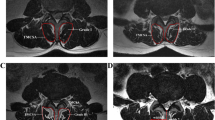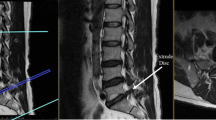Abstract
Objective
To assess multifidus muscle asymmetry using the cross-sectional area (CSA) and perpendicular distance of the multifidus muscle to the lamina (MLD) measurements in patients with nerve compression due to lumbosacral disc hernia.
Materials and methods
In total, 122 patients who underwent microdiscectomy for unilateral radiculopathy caused by disc herniation, diagnosed by magnetic resonance imaging (MRI), were evaluated retrospectively. Posterolateral or foraminal disc herniation at only one disc level, the L3-4, L4-L5, or L5-S1 region, was confirmed using MRI. Subjects were divided by symptom duration: 1–30 days, (group A), 31–90 days (group B), and > 90 days (group C). There were 48 cases in group A, 26 in group B, and 48 in group C.
Results
In groups A, B, and C, the median MLD differed significantly between the diseased and normal sides (P < 0.05). The MLD increased on the diseased side with symptom duration by lumbar disc herniation. The diseased side MLD was 5.1, 6.7, and 7.6 mm in groups A, B, and C, respectively (P < 0.05). The cut-off values for the MLD measurements were 5.3 mm (sensitivity = 62.3 %, specificity = 55.5 %; P < 0.05). In groups A, B, and C, the median CSA of the multifidus muscle was not significantly different between the diseased and the normal side (P > 0.05).
Conclusions
The MLD measurement correlated significantly with multifidus asymmetry in patients with lumbar disc herniation.



Similar content being viewed by others
References
Zhao WP, Kawaguchi Y, Matsui H, Kanamori M, Kimura T. Histochemistry and morphology of the multifidus muscle in lumbar disc herniation: comparative study between diseased and normal sides. Spine. 2000;25:2191–9.
Kader DF, Wardlaw D, Smith FW. Correlation between the MRI changes in the lumbar multifidus muscles and leg pain. Clin Radiol. 2000;55:145–9.
Franke J, Hesse T, Tournier C, Schuberth W, Mawrin C, LeHuec JC, et al. Morphological changes of the multifidus muscle in patients with symptomatic lumbar disc herniation. J Neurosurg Spine. 2009;11:710–4.
Yoshihara K, Shirai Y, Nakayama Y, Uesaka S. Histochemical changes in the multifidus muscle in patients with lumbar intervertebral disc herniation. Spine. 2001;26:622–6.
Hyun JK, Lee JY, Lee SJ, Jeon JY. Asymmetric atrophy of multifidus muscle in patients with unilateral lumbosacral radiculopathy. Spine. 2007;32:598–602.
Kim WH, Lee SH, Lee DY. Changes in the cross-sectional area of multifidus and psoas in unilateral sciatica caused by lumbar disc herniation. J Korean Neurosurg Soc. 2011;50:201–4.
Farshad M, Gerber C, Farshad-Amacker NA, Dietrich TJ, Laufer-Molnar V, Min K. Asymmetry of the multifidus muscle in lumbar radicular nerve compression. Skelet Radiol. 2014;4:49–53.
Battié MC, Niemelainen R, Gibbons LE, Dhillon S. Is level- and side-specific multifidus asymmetry a marker for lumbar disc pathology? Spine J. 2012;12:932–9.
Pfirrmann CW, Dora C, Schmid MR, Zanetti M, Hodler J, Boos N. MR image-based grading of lumbar nerve root compromise due to disk herniation: reliability study with surgical correlation. Radiology. 2004;230:583–8.
Woodham M, Woodham A, Skeate JG, Freeman M. Long-term lumbar multifidus muscle atrophy changes documented with magnetic resonance imaging: a case series. J Radiol Case Rep. 2014;8:27–34.
Hodges P, Holm AK, Hansson T, Holm S. Rapid atrophy of the lumbar multifidus follows experimental disc or nerve root injury. Spine. 2006;31:2926–33.
Choi G, Raiturker PP, Kim MJ, Chung DJ, Chae YS, Lee SH. The effect of early isolated lumbar extension exercise program for patients with herniated disc undergoing lumbar discectomy. Neurosurgery. 2005;57:764–72.
Hansen L, de Zee M, Rasmussen J, Andersen TB, Wong C, Simonsen EB. Anatomy and biomechanics of the back muscles in the lumbar spine with reference to biomechanical modeling. Spine. 2006;31:1888–99.
Conflict of interests
Neither the authors nor the author’s institutions have any conflicts of interest to report. No financial support from any institution was used.
Author information
Authors and Affiliations
Corresponding author
Rights and permissions
About this article
Cite this article
Altinkaya, N., Cekinmez, M. Lumbar multifidus muscle changes in unilateral lumbar disc herniation using magnetic resonance imaging. Skeletal Radiol 45, 73–77 (2016). https://doi.org/10.1007/s00256-015-2252-z
Received:
Revised:
Accepted:
Published:
Issue Date:
DOI: https://doi.org/10.1007/s00256-015-2252-z




